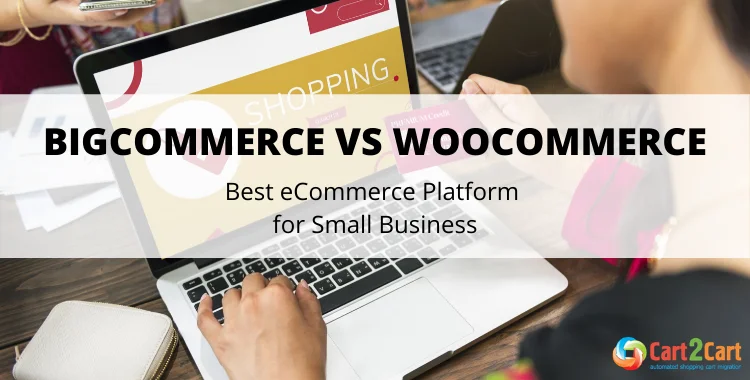The web market is full of eCommerce solutions. They provide everything needed to build and manage an online store. Think twice before choosing the software to settle your e-store on. Making the wrong decision can harm your online business for years and cost you a fortune and time to rectify. Our today's post is dedicated to the BigCommerce vs WooCommerce opposition. Read on to find out more.
Table of Contents:
What is BigCommerce vs WooCommerce?
Both WooCommerce and BigCommerce are robust and fast-growing solutions, and there’s no outspoken leader between them. In short, if the budget is your crucial priority, go with WooCommerce, as BigCommerce pricing bites a little. Looking for an all-in-one solution, that doesn’t require any tech skills? Give BC a try.
According to Google Trends stats, WooCommerce's popularity is rapidly increasing in search trends, but in recent years BigCommerce tries its best to get up to speed. It still has a lot more catching up to do, but its popularity is growing as well.
WooCommerce vs Wix. Easy Online Website Builder Or Robust eCommerce Plugin?.
BigCommerce vs WooCommerce. Brief intro
When considering to start an online shop, you should look at the pros and cons of going with a dedicated hosted platform like Bigcommerce or a self-managed WordPress plugin Woocommerce. Both BigCommerce vs WooCommerce have a lot to offer. either a beginner and an advanced merchant, and narrowing down your options can be tricky. Let's compare the two platforms to find out the drawbacks and benefits of these counterparts. For those looking to move, understanding our migration preview service can be a crucial first step.
Looking for a perfect platform for your online store? How about running a free demo with Cart2Cart to test-drive the desired solution?
BigCommerce
In 2009 Aussies Eddie Machaalani and Mitchel Harper launched the SaaS ecommerce solution now known as BigCommerce. It's famous for its high reliability, ease of use, beautiful templates, multifunctionality, and quality consumer support. Cloud-based and user-friendly, this platform helps merchants from all levels of experience and revenue sell their products online successfully. If you choose BigCommerce, bear in mind that there is room for improvement in advanced features or customizability for large retailers and companies. It's up to you to decide. Cart2Cart team believes that BigCommerce has more advantages than disadvantages, especially for small business. You can prepare for your move with our BigCommerce migration checklist.
Here's a good BigCommerce review from the WebsiteBuilderExpert:
WooCommerce
With millions of live websites on the board, WooCommerce becomes one of the most popular WordPress site plugins. Thanks to its expandability, flexibility, and robustness, the number of loyal clients is growing. Since its establishment in 2011, the platform boasts millions of active installations throughout the world. But the most important feature, which keeps WooCommerce at the top of the league is its freemium model. This bling enables you to decide on experiments and to try many different methods or strategies when running your business. No loss - no fear, right? Since sometimes, courage works miracles. Perhaps it's a great time to take action?
BigCommerce vs WooCommerce. Technical Support
It’s commonly known, that teamwork provides promising prospects, especially when sifting through the countless options for a new eCommerce store is overwhelming. Who'd turn a helping hand down, being far from coding and programming skills (especially if this helping hand is knowledgeable and tech-savvy customer service)? Understanding the potential benefits of a website migration can often start with evaluating its support system.
Magento vs WooCommerce vs Shopify vs OpenCart vs PrestaShop In-Depth Comparison
BigCommerce
As for BigCommerce support, this platform is diversity itself. It empowers customers with numerous help options, provides 24/7 personal tech support via different channels (e.g., email, live chat, and phone). Fortunately, this kind of help is available at all levels. In case you’d prefer to take matters into your own hands, BigCommerce has lots of online auxiliary resources as well:
- Developer Documentation: guidance notes on old-school Blueprint themes and brand new Stencil outlines as well; API guides for building integrations
- Strong Platform Community: you can find experienced developers to customize your eStore;
- Webinars: the archive of the topical videos are at your disposal;
- Guides: how-to documentation, eCommerce best practices, troubleshooting articles for setting up and managing your online shop;
- BigCommerce Forum: in case you’ve bumped into a common problem, find the solution and bring to light any difficulties you may encounter;
-
University: a number of professional video tutorials that lead you through the basics of using BigCommerce.
If you'd wish to contact BigCommerce technical support directly, you're welcome to use:
- Phone: visit the official page for numbers by country;
- Live Chat;
- Web Ticket;
- Email;
- Social Media Profiles: keep in touch with BigCommerce via their Facebook and Twitter profiles.
WooCommerce
WooCommerce would also never abandon its customers. But as in the case with most free open-source platforms, the personal customer service here is quite limited. Unfortunately, you cannot get help through social media, email, or phone, although you can submit a web ticket. Via live chat, WooCommerce will immediately give the response to your request. However, there's a reason for such restricted tech support: one of the best things concerning WooCommerce is that it is easy to download, use, and set up. The setup process takes you through a simple setup wizard with hits and instructions. You have to choose the currency and tax rates, set up a payment gateway, and build the main WooCommerce store pages (e.g., Shop, Cart, and Checkout).
You will need advanced customer help if you decide to equip the site with lots of non-Woo products. Thus, you'll need to make these third-party products invalid before they can provide any aid. Simplifying the process of managing various products and customer data during a platform change can be achieved with our CSV migration service or a more comprehensive Basic Data Migration Service.
Simply put, WooCommerce offers you access to lots of self-help options, including:
- FAQs;
- Community Forum;
- Blog;
- Documentation and how-to writings;
- Woo-experts for hire.
Please, note: WooCommerce plugin integrates with WordPress, but they both are not the same. With questions, regarding WordPress, contact its Help Centre, instead of WooCommerce.
BigCommerce vs WooCommerce. The Trade in Question
Usually, an ideal vision falls apart like a house of cards in a blink of an eye when it comes to price. Especially if you're looking for a trusted solution for startups and growing businesses. The beginners can hardly finance too expensive platforms. You're lucky, far from all sales panels will cost you an arm and a leg.
BigCommerce
Before listing available pricing plans, we should mention, that BigCommerce provides 15-day free trial with no credit cards, no transactions and no payment required. Refunds are collected on a monthly basis, and the cancellation fee isn’t implemented. But there’s no need to purchase the monthly plans. Take advantage of a 10% discount while deciding on a one-year subscription instead.
Flexible pricing policy is another reason for choosing this platform. The cost will depend on your store's annual online sales. It has a different structure than some of BigCommerce's main competitors. If your profit and revenue go beyond the set amount for a specific plan, the eStore will be upgraded to the next pricing tier automatically.
Shopify vs WooCommerce. Which One Is Better For Your Online Business?
Here’s the complete list of BigCommerce plans:
-
Standard Plan ($39 per month for sales up to $50K annually); The tier includes unlimited storage, products, and traffic.
-
Plus Plan ($105 per month for sales up to $180K annually); Choosing this offer, you’ll gain access to numerous marketing tools (e.g., customer groups, shoppers segmentation, credit card storage, abandoned cart saver and etc.).
-
Pro Plan (from $399 monthly for sales under $400K per year); For this additional expense store owner gets Google customer reviews, product filtering option, and ability to bring over an SSL that you may have purchased from another SSL provider.
-
Enterprise Plan (custom pricing). This solution is a great choice for large retailers, who can afford to pay quite a lot of jack for advanced features proposed. This benefit-list involves price lists, unlimited API calls, the usage of custom product fields as product filters in the faceted search, premium account services, express routing, priority support, and strategic account management.
WooCommerce
Let us guess, you're wondering now what is FREE WordPress plugin doing here? It's not that simple, guys. Since excellent business is not about altruism. The great news is that WooCommerce is 100% free of charge to download! You can find it on WordPress.org and get started without paying a penny. But moving forward, you'll come upon demand to pay for some extensions, WooCommerce themes, or extra services over and over again. It's the inevitable result, whether you like it or not. And the priority is buying web hosting and domain name. For more insights on preparation, check our pre-migration tips. Our WooCommerce migration checklist can help you plan these steps. You also have to get a WooCommerce-ready theme. This means that the theme works with WooCommerce and will look perfect with your eCommerce pages, such as products, categories, cart, and checkout.
For achieving the best use out of the platform, you'll have to buy various add-ons and extensions, which range in price from free to hundreds of dollars. However, because many of these extensions are one-time purchases, you'll probably come out paying slightly less than you would with another popular option. If you're planning a major overhaul or transfer, our Ultimate Data Migration Service provides a comprehensive solution.
WordPress Migration Checklist for establishing your store
BigCommerce vs WooCommerce. Diverse Design
A website builder's remarkable strength in support, ease-of-use, or something else will become insignificant if its templates are boring and poor in quality. The thing to bear in mind is: your customer does not see backstage and doesn't want to know. All he cares about is a neatly-organized interface and high-quality products. Everything else is a hassle. Thus the platform of your choice should be capable of providing you with beautiful templates and handy design. Let's find out which platform can do it better.
BigCommerce
Bigcommerce prides itself on producing themes that fit all kinds of purposes and types of eCommerce shops. Its reasonably good selection of responsive Stencil templates are pre-made for new merchants, and if you're still using legacy Blueprint designs, start thinking about an upgrade. There are free and premium templates, going for around $120-300 apiece, so no matter what you might be selling, their multipurpose nature allows the usage for all kinds of stores and products. So the way to go about choosing your theme would be to look for something that's in tune with your brand. BigCommerce store includes a ton of modifications for available themes (hundreds of total variations and several for free themes).
Check out the list of eCommerce website features you can not ignore
WooCommerce
Although it is possible to integrate WooCommerce into any WordPress.com theme, we recommend using a WooTheme for a couple of reasons: First off, using a WooTheme reduces headaches involved with applying WooCommerce updates. Secondly, WooCommerce's web ticket support only applies to Woo products. Read WooCommerce's Support Policy to learn more.
WooCommerce provides their free Storefront theme to all users. They also offer several free and premium child themes. While Storefront is not the most exciting template we've ever seen, it's alright for a free theme that works smoothly with all WooCommerce updates.
WooCommerce has introduced a unique Storefront Powerpack extension bundle ($69 for a single site). This extension includes tools for customizing your Storefront site's look and feel without touching any code.
If you'd prefer even more control over the look of your store, you can always add free and paaid plugins or child themes or edit the HTML and CSS stylesheets. Because WooCommerce is open source, there are no limits to the customizations you can make to your platform. But, you should be aware that you're less likely to benefit from WooCommerce's web ticket support if you customize your store's code.
WooCommerce comes with some styling to make it work with most themes. However, in practice, it's best to use a WooCommerce-ready theme. This is because your store pages will have been properly designed to look good with your theme. They will look more professional.
Read the our advice on how to choose the best eCommerce platform
Check out our infographic to get a better understanding of the migration process via Cart2Cart:
BigCommerce vs WooCommerce FAQs
Does BigCommerce integrate with WooCommerce?
No, it is impossible to integrate BigCommerce with WooCommerce. However, if your wish to run your business on WooCommerce, it is possible to migrate your store's database from BigCommerce to WooCommerce in a totally automated way with Cart2Cart.
What is better than WooCommerce?
It all depends on the purpose and size of your online business. And also the level of your tech expertise, of course. WooCommerce is currently the most popular solution, but you can easily migrate your products, customers and more to any of the desired platforms with Cart2Cart.
Is BigCommerce good for ecommerce?
Yes, BigCommerce is prefect if you are looking for a multi-channel selling and have enough patience and skills to establish your own store. It has many build-in features and great SEO support.
Final Slice
Leave a Reply Cancel reply
There is nothing left to think about! Cart2Cart will perform your migration either from BigCommerce to WooCommerce, or from WooCommerce to BigCommerce accurately and smoothly in no time for reasonable price.
What can we do for you?
Start Free Demo, become an eCommerce leader! Don't miss this unique opportunity to grow your business.
Monthly Update – December 2025
As we approach December 2025, the imperative for advanced security in eCommerce is more pronounced than ever. With an increasing volume of online transactions and sensitive customer data, store owners must prioritize robust security measures. This includes implementing multi-factor authentication, ensuring PCI DSS compliance, regularly updating software and plugins, and utilizing secure payment gateways. For merchants undertaking a platform migration, this focus on security extends to the migration process itself. Ensuring that data is transferred securely, without vulnerabilities, and that the new platform inherits or enhances existing security protocols is critical. Leveraging services that offer encrypted data transfer and adhere to strict data protection standards is paramount. A secure migration safeguards customer trust, prevents data breaches, and protects your business from significant financial and reputational damage. Furthermore, continuous monitoring and proactive threat detection post-migration are essential to maintain a resilient and trustworthy online store in the evolving digital threat landscape.
For more details, explore our FAQ section or schedule a call with a migration expert.














